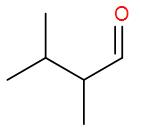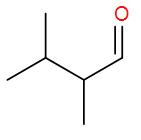Answer
393.3k+ views
Hint: The compound name given ends with –al meaning it is a carbonyl group is present in the compound and the main chain contains but- 4 carbon atoms. A representation of molecular structure, in which covalent bonds are represented for each degree of bond order with one side is a bond line structure.
Complete answer:
A representation of molecular structure, in which covalent bonds are represented for each degree of bond order with one side. One single bond is represented with one line, two parallel lines show a double bond, and three parallel lines show a triple bond. Carbon atom position may be indicated with letters, or may be inferred. Similar structure to, but not identical to, Lewis.
This formula is full of bonds and lines, and they sometimes end up looking like zig-zag lines because of the typical (more stable) bonds which atoms appear to make in molecules. If you're dealing with a molecular model package, it's hard to make stick straight molecules (unless they include $sp$ triple bonds) whereas zig-zag molecules and bonds are far more feasible.
- Here we are asked to make a bond line formula for the given compound.
- Firstly, let’s understand what a bond line formula is. It is a 2-D representation of molecular structure in which the bonds between the atoms are shown by lines which can represent single or multiple bonds.
- Now the bond line formula of the given compound 2,3-dimethyl butanal:
 Molecular Formula : \[{{C}_{6}}{{H}_{12}}O\]
Molecular Formula : \[{{C}_{6}}{{H}_{12}}O\]
- As we can see the compound has a carbon to oxygen double bond, the functional group present is carbonyl group.
- The general formula for carbonyl compounds is ${{C}_{n}}{{H}_{2n}}O$
- We can define two families from a carbonyl group: Aldehydes and Ketones.
- As we know Aldehyde and Ketone are functional isomers.
So, bond line formula for 2,3-dimethyl butanal is

Note:
- This formula is full of bonds and lines, and they sometimes end up looking like zig-zag lines because of the typical (more stable) bonds which atoms appear to make in molecules
-$-CHO$ group is always at the end of the carbon chain, while $-CO-$ is always present in the middle of the chain.
Complete answer:
A representation of molecular structure, in which covalent bonds are represented for each degree of bond order with one side. One single bond is represented with one line, two parallel lines show a double bond, and three parallel lines show a triple bond. Carbon atom position may be indicated with letters, or may be inferred. Similar structure to, but not identical to, Lewis.
This formula is full of bonds and lines, and they sometimes end up looking like zig-zag lines because of the typical (more stable) bonds which atoms appear to make in molecules. If you're dealing with a molecular model package, it's hard to make stick straight molecules (unless they include $sp$ triple bonds) whereas zig-zag molecules and bonds are far more feasible.
- Here we are asked to make a bond line formula for the given compound.
- Firstly, let’s understand what a bond line formula is. It is a 2-D representation of molecular structure in which the bonds between the atoms are shown by lines which can represent single or multiple bonds.
- Now the bond line formula of the given compound 2,3-dimethyl butanal:

- As we can see the compound has a carbon to oxygen double bond, the functional group present is carbonyl group.
- The general formula for carbonyl compounds is ${{C}_{n}}{{H}_{2n}}O$
- We can define two families from a carbonyl group: Aldehydes and Ketones.
- As we know Aldehyde and Ketone are functional isomers.
So, bond line formula for 2,3-dimethyl butanal is

Note:
- This formula is full of bonds and lines, and they sometimes end up looking like zig-zag lines because of the typical (more stable) bonds which atoms appear to make in molecules
-$-CHO$ group is always at the end of the carbon chain, while $-CO-$ is always present in the middle of the chain.
Recently Updated Pages
Basicity of sulphurous acid and sulphuric acid are

Three beakers labelled as A B and C each containing 25 mL of water were taken A small amount of NaOH anhydrous CuSO4 and NaCl were added to the beakers A B and C respectively It was observed that there was an increase in the temperature of the solutions contained in beakers A and B whereas in case of beaker C the temperature of the solution falls Which one of the following statements isarecorrect i In beakers A and B exothermic process has occurred ii In beakers A and B endothermic process has occurred iii In beaker C exothermic process has occurred iv In beaker C endothermic process has occurred

What is the stopping potential when the metal with class 12 physics JEE_Main

The momentum of a photon is 2 times 10 16gm cmsec Its class 12 physics JEE_Main

How do you arrange NH4 + BF3 H2O C2H2 in increasing class 11 chemistry CBSE

Is H mCT and q mCT the same thing If so which is more class 11 chemistry CBSE

Trending doubts
Difference between Prokaryotic cell and Eukaryotic class 11 biology CBSE

Difference Between Plant Cell and Animal Cell

Change the following sentences into negative and interrogative class 10 english CBSE

Fill the blanks with the suitable prepositions 1 The class 9 english CBSE

How many crores make 10 million class 7 maths CBSE

How fast is 60 miles per hour in kilometres per ho class 10 maths CBSE

What organs are located on the left side of your body class 11 biology CBSE

Give 10 examples for herbs , shrubs , climbers , creepers

One Metric ton is equal to kg A 10000 B 1000 C 100 class 11 physics CBSE



